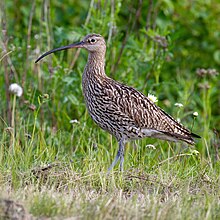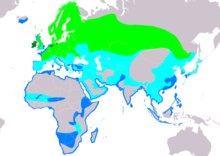| Eurasian curlew | |
|---|---|

| |
| A male Eurasian curlew | |
| Song | |
| Conservation status | |
 Near Threatened (IUCN 3.1) | |
| Scientific classification | |
| Domain: | Eukaryota |
| Kingdom: | Animalia |
| Phylum: | Chordata |
| Class: | Aves |
| Order: | Charadriiformes |
| Family: | Scolopacidae |
| Genus: | Numenius |
| Species: | N. arquata |
| Binomial name | |
| Numenius arquata (Linnaeus, 1758) | |

| |
| Global map of N. arquata Year-round range Summer range Passage Winter range | |
| Synonyms | |
| |
The Eurasian curlew or common curlew (Numenius arquata) is a very large wader in the family Scolopacidae. It is one of the most widespread of the curlews, breeding across temperate Europe and Asia. In Europe, this species is often referred to just as the "curlew", and in Scotland known as the "whaup" in Scots.
Taxonomy
The Eurasian curlew was formally described by the Swedish naturalist Carl Linnaeus in 1758 in the tenth edition of his Systema Naturae under the binomial name Scolopax arquata. It is now placed with eight other curlews in the genus Numenius that was introduced by the French ornithologist Mathurin Jacques Brisson in 1760. The genus name Numenius is from Ancient Greek νουμήνιος, noumēnios, a bird mentioned by Hesychius. It is associated with the curlew because it appears to be derived from neos, "new" and mene "moon", referring to the crescent-shaped bill. The species name arquata is the Medieval Latin name for this bird, derived from Latin arcuatus, "bow-shaped", and again referring to the shape of the bill.
The English name "curlew" is imitative of the Eurasian curlew's call, but may have been influenced by the Old French corliu, "messenger", from courir , "to run". It was first recorded in 1377 in Langland's Piers Plowman "Fissch to lyue in þe flode..Þe corlue by kynde of þe eyre".
Three subspecies are recognised:
- N. a. arquata, (Linnaeus, 1758) – breeds in west, north & central Europe
- N. a. orientalis, Brehm – 1831 – breeds in west & central Siberia through to Northeast China
- N. a. suschkini, Neumann, 1929 – breeds from western Kazakhstan to southwestern Siberia
Description
The Eurasian curlew is the largest wader in its range, at 50–60 cm (20–24 in) in length, with an 89–106 cm (35–42 in) wingspan and a body weight of 410–1,360 g (0.90–3.00 lb). It is mainly greyish brown, with a white back, greyish-blue legs and a very long curved bill. Males and females look identical, but the bill is longest in the adult female. It is generally not possible to recognize the sex of a single Eurasian curlew, or even several ones, as there is much variation; telling male and female of a mated pair apart is usually possible however. The familiar call is a loud curloo-oo.
The only similar species over most of the curlew's range is the Eurasian whimbrel (Numenius phaeopus). The whimbrel is smaller and has a shorter bill with a kink rather than a smooth curve. Flying curlews may also resemble bar-tailed godwits (Limosa lapponica) in their winter plumages; however, the latter have a smaller body, a slightly upturned beak, and legs that do not reach far beyond their tail tips. The Eurasian curlew's feet are longer, forming a conspicuous "point".
Distribution and habitat
The curlew exists as a migratory species over most of its range, wintering in Africa, southern Europe and south Asia. Occasionally a vagrant individual reaches places far from its normal range, such as Nova Scotia and the Marianas. It is present all year in the milder climates of Ireland and the United Kingdom and its adjacent European coasts.
Reclamation and drainage of marshy fields and moorland, and afforestation of the latter, have led to local decreases, while conversion of forest to grassland in some parts of Scandinavia has led to increases there.
Behaviour and ecology
The Eurasian curlew is generally wary. It is highly gregarious outside the breeding season.
Breeding
The nest is a bare scrape on taiga, meadow, and similar habitats. The clutch size of the curlew consists of four eggs which are laid in April or May, and the mother incubates them for about a month until they begin to hatch. It has been observed that curlews tend to nest close to common kestrels’ nests, as they can offer protection from other predators, such as corvids, even though kestrels also prey on curlew nests.
-
 clutch of eggs
clutch of eggs
-
Eggs Museum Wiesbaden, Germany
-
 In flight, Argyll, Scotland
In flight, Argyll, Scotland
-
skull
Food and feeding
The Eurasian curlew feeds by probing soft mud for small invertebrates, but will also pick small crabs and earthworms from the surface if the opportunity arises.
Predation
Eurasian curlews eggs are preyed on by foxes and predatory birds. In addition sheep have been recorded by the BBC nature series Springwatch preying on the eggs.
Status
The Eurasian curlew was formerly listed as a species of Least Concern by the IUCN, owing to its expansive range and relatively large population. However, the population of the Eurasian curlew was noticed to be declining at a very rapid rate. Following the evaluation of its population trend, the classification was found to be outdated, and it was consequently promoted to Near Threatened status in 2008. Though it is a common bird, its numbers are noticeably declining, particularly in the United Kingdom and Ireland, which have about a quarter of the global population. In the twenty years up to 2016, the population is estimated to have declined by more than 50% in England and Scotland, more than 80% in Wales, and more than 90% in Ireland. At the end of 2015 it was placed on the United Kingdom's red list of most endangered bird species. The curlew is one of the species to which the Agreement on the Conservation of African-Eurasian Migratory Waterbirds (AEWA) applies.
Research by scientists at the British Trust for Ornithology suggests that curlew populations in the UK have been negatively affected in areas with high levels of arable farming and afforestation which have reduced its natural habitats of open grasslands.
Gallery
-
 Eurasian Curlew at Chilika Lake, India
Eurasian Curlew at Chilika Lake, India
-
 Eurasian curlew pictured in the former coat of arms of Oulunsalo, Finland
Eurasian curlew pictured in the former coat of arms of Oulunsalo, Finland
References
- ^ BirdLife International (2017). "Numenius arquata". IUCN Red List of Threatened Species. 2017: e.T22693190A117917038. doi:10.2305/IUCN.UK.2017-3.RLTS.T22693190A117917038.en. Retrieved 11 November 2021.
- Linnaeus, Carl (1758). Systema Naturae per regna tria naturae, secundum classes, ordines, genera, species, cum characteribus, differentiis, synonymis, locis (in Latin). Vol. 1 (10th ed.). Holmiae (Stockholm): Laurentii Salvii. p. 145.
- Brisson, Mathurin Jacques (1760). Ornithologie, ou, Méthode contenant la division des oiseaux en ordres, sections, genres, especes & leurs variétés (in French and Latin). Vol. 1. Paris: Jean-Baptiste Bauche. Vol. 1, p. 48, Vol. 5, p. 311.
- ^ Gill, Frank; Donsker, David; Rasmussen, Pamela, eds. (July 2021). "Sandpipers, snipes, coursers". IOC World Bird List Version 11.2. International Ornithologists' Union. Retrieved 20 November 2021.
- Jobling, James A (2010). The Helm Dictionary of Scientific Bird Names. London: Christopher Helm. pp. 56, =276. ISBN 978-1-4081-2501-4.
- "Curlew". Oxford English Dictionary (Online ed.). Oxford University Press. (Subscription or participating institution membership required.)
- Dunning, John B. Jr., ed. (1992). CRC Handbook of Avian Body Masses. CRC Press. ISBN 978-0-8493-4258-5.
- "Eurasian Curlew". Birds of Nova Scotia. Natural History Museum of Nova Scotia (NHMNS). 1998. Archived from the original on 28 August 2008. Retrieved 23 May 2008.
- Wiles, Gary J.; Worthington, David J.; Beck, Robert E. Jr.; Pratt, H. Douglas; Aguon, Celestino F.; Pyle, Robert L. (2000). "Noteworthy Bird Records for Micronesia, with a Summary of Raptor Sightings in the Mariana Islands, 1988–1999" (PDF). Micronesica. 32 (2): 257–284. Archived from the original (PDF) on 2013-04-23.
- Wiles, Gary J.; Johnson, Nathan C.; de Cruz, Justine B.; Dutson, Guy; Camacho, Vicente A.; Kepler, Angela Kay; Vice, Daniel S.; Garrett, Kimball L.; Kessler, Curt C.; Pratt, H. Douglas (2004). "New and Noteworthy Bird Records for Micronesia, 1986–2003". Micronesica. 37 (1): 69–96. Archived from the original on 2009-05-05.
- Encyclopedia of the Animal World (1977): Vol.6: 518–519. Bay Books, Sydney.
- Norrdahl, K., Suhonen, J., Hemminki, O. et al. Oecologia (1995) 101: 105. https://doi.org/10.1007/BF00328906
- "Conserving the curlew - Game and Wildlife Conservation Trust". www.gwct.org.uk. Retrieved 2022-11-05.
- Kossoff, Julian (2018-05-30). "Killer Sheep Discovered Wolfing Down Bird Chicks". International Business Times. Retrieved 2022-11-05.
- Winter, Stuart (2018-05-30). "BBC Springwatch: Chris Packham SHOCKED by KILLER SHEEP". Express.co.uk. Retrieved 2022-11-05.
- McCarthy, Michael (22 February 2016). "Nature Studies: If we lose the curlew, we lose the sound of the British wilderness". The Independent. Retrieved 11 April 2017.
- "Species". Agreement on the Conservation of African-Eurasian Migratory Waterbirds (AEWA). Retrieved 14 November 2021.
- Franks, Samantha E.; Douglas, David J. T.; Gillings, Simon; Pearce-Higgins, James W. (2017-07-03). "Environmental correlates of breeding abundance and population change of Eurasian Curlew Numenius arquata in Britain". Bird Study. 64 (3): 393–409. Bibcode:2017BirdS..64..393F. doi:10.1080/00063657.2017.1359233. ISSN 0006-3657. S2CID 89966879.
External links
- Conserving breeding curlews in Southern England
- (Eurasian) curlew species text in The Atlas of Southern African Birds
- Video of a Curlew Probing the Mud in the Thames Estuary
- "Numenius arquata". Avibase.

- "Eurasian curlew media". Internet Bird Collection.
- Eurasian curlew photo gallery at VIREO (Drexel University)
- Interactive range map of Numenius arquata at IUCN Red List
- Audio recordings of Eurasian curlew on Xeno-canto.
- Numenius arquata in Field Guide: Birds of the World on Flickr
- Eurasian curlew media from ARKive

| Taxon identifiers | |
|---|---|
| Numenius arquata |
|